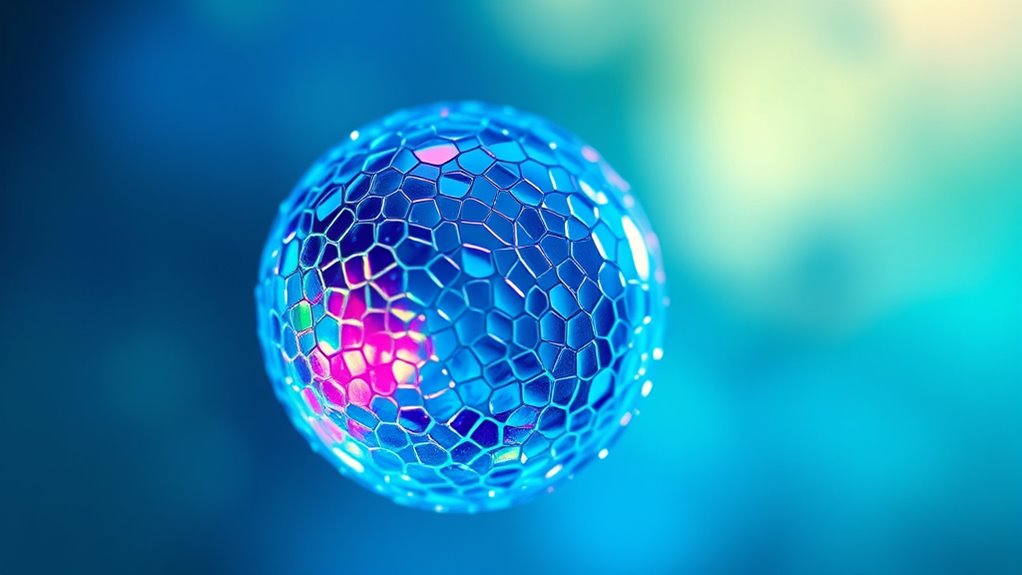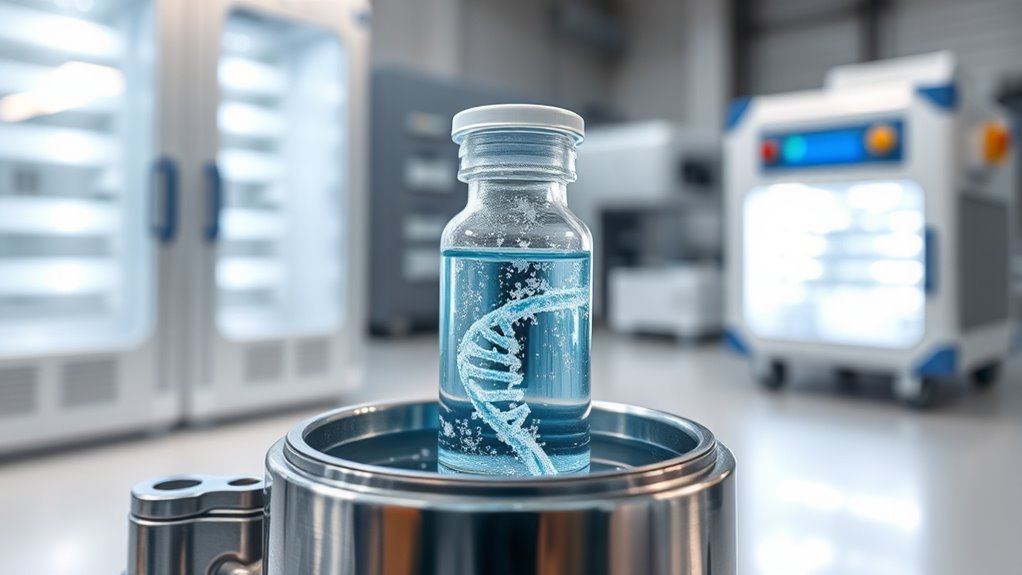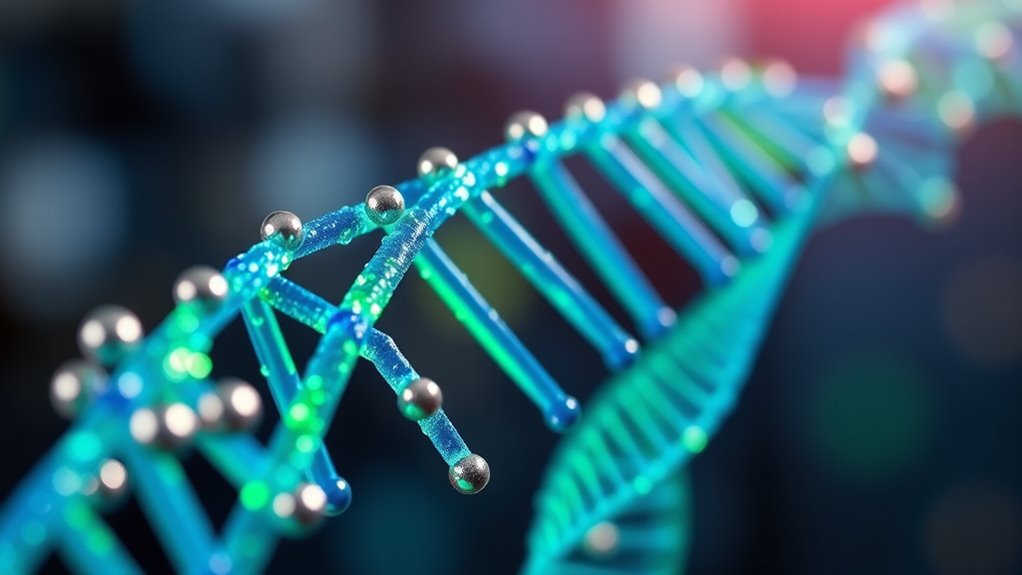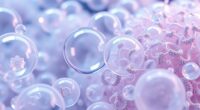The stability of mRNA in vaccines depends on its molecular structure, including a 5′ cap, poly(A) tail, and specific UTR motifs that protect it from degradation. Delivery systems like lipid nanoparticles shield the mRNA and enhance cellular uptake, while proper storage conditions—such as ultra-cold temperatures—prevent breakdown. Analytical techniques track integrity, and chemical modifications improve durability. To learn how these factors combine to keep vaccines effective, explore the detailed chemistry behind mRNA stability.
Key Takeaways
- Chemical modifications like pseudouridine and 5-methylcytidine enhance mRNA stability by reducing immune recognition and nuclease susceptibility.
- The 5′ cap structure protects mRNA from exonucleases and promotes translation efficiency.
- Optimized poly(A) tail length and terminal modifications delay deadenylation, extending mRNA half-life.
- Lipid nanoparticle composition, including ionizable lipids and PEGylated lipids, shields mRNA from degradation during delivery.
- Storage conditions, such as ultra-cold temperatures and the use of stabilizers, are crucial for maintaining mRNA integrity in vaccines.
Intrinsic Factors Influencing Mrna Stability

Intrinsic factors play an essential role in determining mRNA stability, directly affecting how long the molecule persists in a cell or vaccine formulation. The 5′ cap shields your mRNA from exonuclease degradation and boosts translation. A longer poly(A) tail extends mRNA half-life by slowing deadenylation. Untranslated regions (UTRs) contain sequence motifs that attract RNA-binding proteins, influencing stability—some stabilize, others promote decay. Optimizing the coding sequence, especially codon usage, affects secondary structures, which can either protect or expose vulnerable sites. Additionally, the natural secondary and tertiary structures of mRNA can shield degradation sites or make them accessible. These structural elements are essential for maintaining stability, ensuring your mRNA remains intact long enough to produce the desired immune response or therapeutic effect. Understanding mRNA stability factors is crucial for designing effective vaccines, and advances in sound design techniques can aid in visualizing and modeling these complex structural interactions. Moreover, RNA-binding proteins play a pivotal role in modulating stability by interacting with specific motifs within the mRNA molecule.
Lipid Nanoparticles: Protectors and Challenges

Lipid nanoparticles (LNPs) play a crucial role in safeguarding mRNA molecules during vaccine delivery. They’re composed of ionizable lipids, phospholipids, cholesterol, and PEGylated lipids. The ionizable lipids carry positive charges that bind negatively charged mRNA, enabling encapsulation and delivery into cells. Phospholipids and cholesterol maintain the structural integrity and fluidity of LNPs, helping them fuse with cell membranes. PEGylated lipids create a “stealth” coating, reducing aggregation and immune detection, which extends circulation time. LNPs protect fragile mRNA from enzymatic degradation, ensuring it reaches target cells intact. Ongoing developments in nanoparticle stability aim to improve their safety and efficiency. Additionally, researchers are exploring targeted delivery methods to enhance specificity and reduce side effects. Advances in predictive analytics can help optimize delivery systems and anticipate potential failures. Once inside, they facilitate mRNA release into the cytoplasm. However, challenges include potential toxicity from ionizable lipids, manufacturing complexities, and limited targeting, which require ongoing optimization for safe and effective delivery.
Storage and Transport Stability Concerns

Maintaining the stability of mRNA vaccines during storage and transport presents significant challenges due to their sensitivity to environmental conditions. These vaccines require ultra-cold storage at around -70°C; even slight temperature deviations can accelerate degradation via hydrolysis and oxidation, reducing potency. Security vulnerabilities in new technologies can also pose risks during handling and storage, underscoring the need for strict security measures. Once thawed, vaccines must be used quickly, as physical instability risks like aggregation and precipitation increase at higher temperatures. During transport, temperature fluctuations and mechanical stresses can damage the delicate mRNA-lipid complexes, compromising effectiveness. Using cryoprotectants, specialized insulated containers, and continuous temperature monitoring helps mitigate these risks. Cold chain protocols and strict adherence to them guarantee the vaccines stay within safe conditions, preserving their integrity and efficacy until reaching end users. Proper logistics are vital to prevent degradation and maintain vaccine quality. Additionally, vaccine stability can be enhanced by advances in formulation science, which aim to improve the resilience of mRNA vaccines under less-than-ideal storage conditions.
Analytical Techniques for Monitoring Mrna Integrity

To guarantee mRNA vaccines remain effective, scientists rely on a variety of analytical techniques to monitor their integrity throughout production and storage. High-performance liquid chromatography (HPLC), paired with UV detection, helps you assess mRNA identity, purity, and 5’ capping efficiency.
Meanwhile, anion-exchange chromatography measures poly(A) tail length heterogeneity. Capillary gel electrophoresis (CGE) resolves mRNA by size, detecting fragmentation and impurities like dsRNA.
Spectroscopic and fluorometric assays, such as UV absorbance ratios and RiboGreen dyes, evaluate contamination and concentration. In vitro transcription controls, including enzyme fidelity checks and real-time kinetics, prevent degradation.
Impurity profiling, via cellulose chromatography or RNase digestion, ensures product quality. Combining these techniques gives you a thorough picture of mRNA integrity, critical for vaccine safety and efficacy.
Recent advances in analytical techniques continue to improve the sensitivity and accuracy of mRNA quality assessments, further supporting vaccine development and stability.
Chemical Modifications to Enhance Mrna Durability

Chemical modifications play an essential role in enhancing mRNA durability by protecting it from enzymatic degradation and improving its stability within biological systems.
You can add a 5′-cap with methylation at the N7 position to boost translation efficiency and binding to eIF4E. Incorporating LNA-modified caps or α-PSL analogues further increases stability and prevents decapping.
Nucleotide substitutions like pseudouridine and 5-methylcytidine reduce immune recognition and nuclease attack, while 2′-O-methyl groups protect against hydrolysis.
For the 3′ end, optimizing poly(A) tail length and modifying termini can prevent deadenylation.
Combining these strategies with lipid nanoparticles and excipients like sugars and RNase inhibitors creates a robust, stable mRNA formulation, ensuring it remains intact and functional during storage and delivery.
Frequently Asked Questions
How Do Environmental Factors Affect Mrna Stability During Vaccine Storage?
Environmental factors markedly impact your vaccine’s mRNA stability. If exposed to high temperatures, the mRNA degrades faster, reducing effectiveness.
Light, especially UV, can cause damage, while moisture can lead to hydrolysis.
Mechanical stress during transport may rupture lipid nanoparticles, and pH shifts or metal ions can accelerate breakdown.
To preserve potency, store vaccines in proper conditions, protect them from light and moisture, and handle them gently.
What Are Emerging Methods to Improve Mrna Stability at Higher Temperatures?
You can improve mRNA stability at higher temperatures by adopting emerging methods like advanced capping techniques, such as CleanCap AG, which boosts nuclease resistance and translation.
Incorporate nucleotide modifications like 5-methyluridine and 2-thiouridine to resist degradation.
Using lipid nanoparticle delivery systems with PEGylation and charge-altering polymers offers protection and stability.
Additionally, lyophilization, optimized buffer systems, and excipients help prevent hydrolysis, ensuring the vaccine remains stable even at elevated temperatures.
How Does Mrna Secondary Structure Influence Its Degradation Rate?
Imagine your mRNA as a fortress, where its secondary structure forms walls and battlements. When these walls are strong and well-formed, they shield the core from destructive forces like hydrolysis, slowing degradation.
Conversely, fragile sections or unpaired loops act like open gates, exposing vulnerable sites. So, the more stable and intricate your mRNA’s secondary structure, the longer it resists breakdown, extending its functional lifespan.
Can Lipid Composition Modifications Enhance Vaccine Shelf Life?
You wonder if changing lipid compositions can make vaccines last longer. By tweaking lipids like ionizable lipids or adding stabilizers, you can improve the stability of lipid nanoparticles, which protect mRNA.
These modifications can help vaccines withstand higher temperatures and extend shelf life. So, yes, optimizing lipid formulations is a promising way to enhance vaccine storage and distribution, especially in areas lacking cold chain infrastructure.
What Role Do Adjuvants Play in Mrna Vaccine Stability?
Adjuvants help keep your mRNA vaccine stable by protecting it from enzymes and immune responses that could degrade it. They often use lipid nanoparticles to shield mRNA, preventing breakdown and enhancing delivery.
Modified nucleosides reduce immune recognition, while adjuvants like dsRNA improve immunogenicity without harming stability.
Together, these components guarantee your vaccine’s mRNA remains intact, effective, and capable of producing a strong immune response.
Conclusion
Understanding mRNA stability in vaccines is essential for ensuring their effectiveness, much like a watchmaker carefully maintains a timepiece. By exploring intrinsic factors, lipid nanoparticle protection, storage challenges, and analytical methods, you gain insight into how these vaccines stand the test of time. Just as a cobbler preserves leather for generations, ongoing chemical modifications and advancements keep mRNA vaccines resilient. Staying informed helps you appreciate the delicate science behind these modern marvels, safeguarding public health now and in the future.









